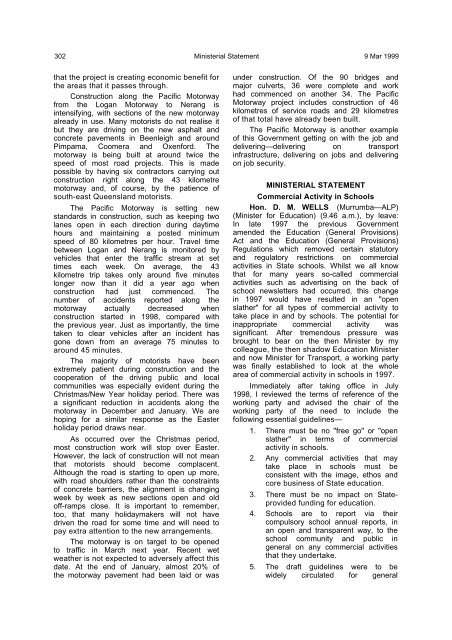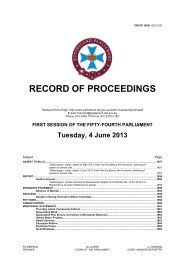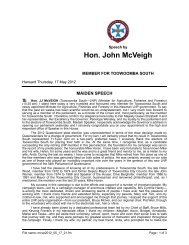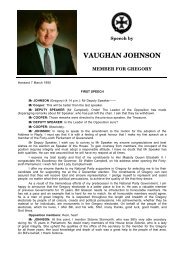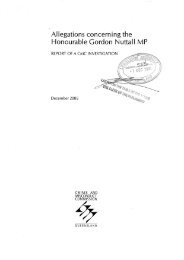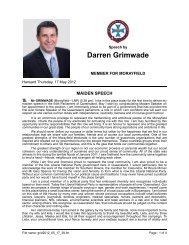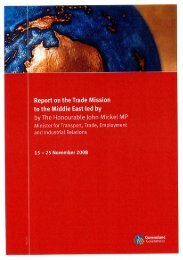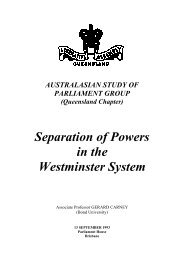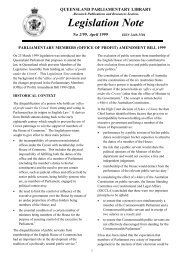Full transcript - Final - Queensland Parliament - Queensland ...
Full transcript - Final - Queensland Parliament - Queensland ...
Full transcript - Final - Queensland Parliament - Queensland ...
Create successful ePaper yourself
Turn your PDF publications into a flip-book with our unique Google optimized e-Paper software.
302 Ministerial Statement 9 Mar 1999<br />
that the project is creating economic benefit for<br />
the areas that it passes through.<br />
Construction along the Pacific Motorway<br />
from the Logan Motorway to Nerang is<br />
intensifying, with sections of the new motorway<br />
already in use. Many motorists do not realise it<br />
but they are driving on the new asphalt and<br />
concrete pavements in Beenleigh and around<br />
Pimpama, Coomera and Oxenford. The<br />
motorway is being built at around twice the<br />
speed of most road projects. This is made<br />
possible by having six contractors carrying out<br />
construction right along the 43 kilometre<br />
motorway and, of course, by the patience of<br />
south-east <strong>Queensland</strong> motorists.<br />
The Pacific Motorway is setting new<br />
standards in construction, such as keeping two<br />
lanes open in each direction during daytime<br />
hours and maintaining a posted minimum<br />
speed of 80 kilometres per hour. Travel time<br />
between Logan and Nerang is monitored by<br />
vehicles that enter the traffic stream at set<br />
times each week. On average, the 43<br />
kilometre trip takes only around five minutes<br />
longer now than it did a year ago when<br />
construction had just commenced. The<br />
number of accidents reported along the<br />
motorway actually decreased when<br />
construction started in 1998, compared with<br />
the previous year. Just as importantly, the time<br />
taken to clear vehicles after an incident has<br />
gone down from an average 75 minutes to<br />
around 45 minutes.<br />
The majority of motorists have been<br />
extremely patient during construction and the<br />
cooperation of the driving public and local<br />
communities was especially evident during the<br />
Christmas/New Year holiday period. There was<br />
a significant reduction in accidents along the<br />
motorway in December and January. We are<br />
hoping for a similar response as the Easter<br />
holiday period draws near.<br />
As occurred over the Christmas period,<br />
most construction work will stop over Easter.<br />
However, the lack of construction will not mean<br />
that motorists should become complacent.<br />
Although the road is starting to open up more,<br />
with road shoulders rather than the constraints<br />
of concrete barriers, the alignment is changing<br />
week by week as new sections open and old<br />
off-ramps close. It is important to remember,<br />
too, that many holidaymakers will not have<br />
driven the road for some time and will need to<br />
pay extra attention to the new arrangements.<br />
The motorway is on target to be opened<br />
to traffic in March next year. Recent wet<br />
weather is not expected to adversely affect this<br />
date. At the end of January, almost 20% of<br />
the motorway pavement had been laid or was<br />
under construction. Of the 90 bridges and<br />
major culverts, 36 were complete and work<br />
had commenced on another 34. The Pacific<br />
Motorway project includes construction of 46<br />
kilometres of service roads and 29 kilometres<br />
of that total have already been built.<br />
The Pacific Motorway is another example<br />
of this Government getting on with the job and<br />
delivering—delivering on transport<br />
infrastructure, delivering on jobs and delivering<br />
on job security.<br />
MINISTERIAL STATEMENT<br />
Commercial Activity in Schools<br />
Hon. D. M. WELLS (Murrumba—ALP)<br />
(Minister for Education) (9.46 a.m.), by leave:<br />
In late 1997 the previous Government<br />
amended the Education (General Provisions)<br />
Act and the Education (General Provisions)<br />
Regulations which removed certain statutory<br />
and regulatory restrictions on commercial<br />
activities in State schools. Whilst we all know<br />
that for many years so-called commercial<br />
activities such as advertising on the back of<br />
school newsletters had occurred, this change<br />
in 1997 would have resulted in an "open<br />
slather" for all types of commercial activity to<br />
take place in and by schools. The potential for<br />
inappropriate commercial activity was<br />
significant. After tremendous pressure was<br />
brought to bear on the then Minister by my<br />
colleague, the then shadow Education Minister<br />
and now Minister for Transport, a working party<br />
was finally established to look at the whole<br />
area of commercial activity in schools in 1997.<br />
Immediately after taking office in July<br />
1998, I reviewed the terms of reference of the<br />
working party and advised the chair of the<br />
working party of the need to include the<br />
following essential guidelines—<br />
1. There must be no "free go" or "open<br />
slather" in terms of commercial<br />
activity in schools.<br />
2. Any commercial activities that may<br />
take place in schools must be<br />
consistent with the image, ethos and<br />
core business of State education.<br />
3. There must be no impact on Stateprovided<br />
funding for education.<br />
4. Schools are to report via their<br />
compulsory school annual reports, in<br />
an open and transparent way, to the<br />
school community and public in<br />
general on any commercial activities<br />
that they undertake.<br />
5. The draft guidelines were to be<br />
widely circulated for general


